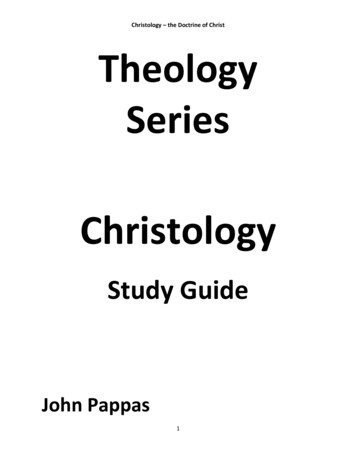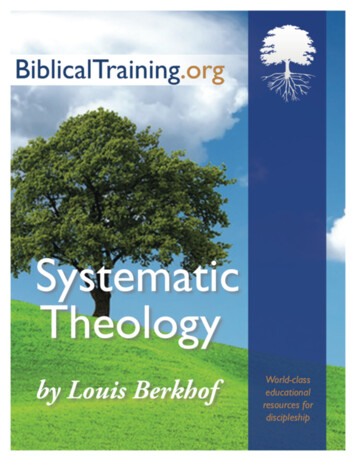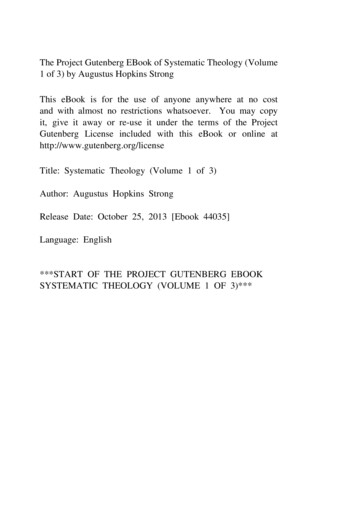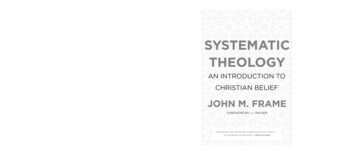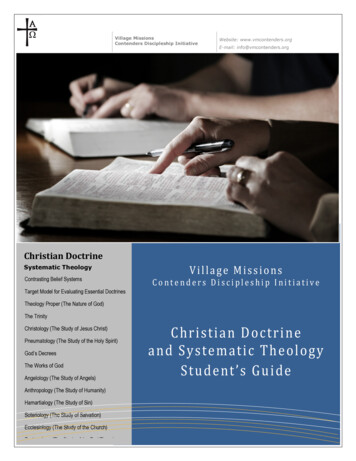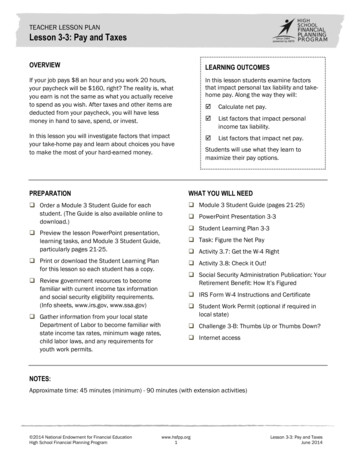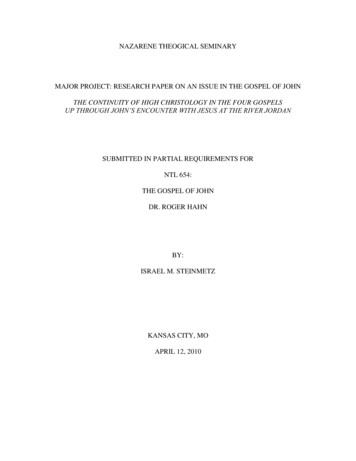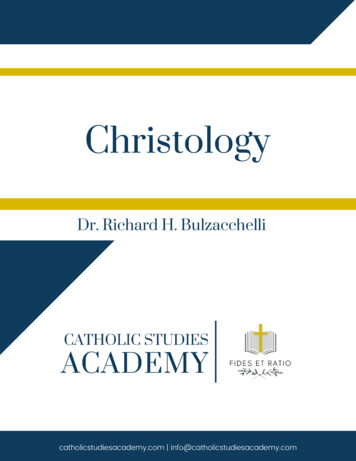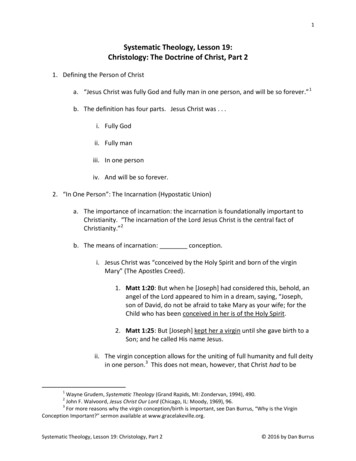
Transcription
1Systematic Theology, Lesson 19:Christology: The Doctrine of Christ, Part 21. Defining the Person of Christa. “Jesus Christ was fully God and fully man in one person, and will be so forever.” 1b. The definition has four parts. Jesus Christ was . . .i. Fully Godii. Fully maniii. In one personiv. And will be so forever.2. “In One Person”: The Incarnation (Hypostatic Union)a. The importance of incarnation: the incarnation is foundationally important toChristianity. “The incarnation of the Lord Jesus Christ is the central fact ofChristianity.”2b. The means of incarnation: conception.i. Jesus Christ was “conceived by the Holy Spirit and born of the virginMary” (The Apostles Creed).1. Matt 1:20: But when he [Joseph] had considered this, behold, anangel of the Lord appeared to him in a dream, saying, “Joseph,son of David, do not be afraid to take Mary as your wife; for theChild who has been conceived in her is of the Holy Spirit.2. Matt 1:25: But [Joseph] kept her a virgin until she gave birth to aSon; and he called His name Jesus.ii. The virgin conception allows for the uniting of full humanity and full deityin one person.3 This does not mean, however, that Christ had to be1Wayne Grudem, Systematic Theology (Grand Rapids, MI: Zondervan, 1994), 490.John F. Walvoord, Jesus Christ Our Lord (Chicago, IL: Moody, 1969), 96.3For more reasons why the virgin conception/birth is important, see Dan Burrus, “Why is the VirginConception Important?” sermon available at www.gracelakeville.org.2Systematic Theology, Lesson 19: Christology, Part 2 2016 by Dan Burrus
2conceived by a virgin, for God could have chosen another method for hisSon to come to earth:1. God could have had Jesus beamed down from heaven resemblingsomething of what you might see on Star Trek. The problem withthis, though, is it would allow for his deity, but not his humanity.We would have a hard time believing that Jesus was actuallyhuman if he came down from heaven. To be human, he neededto be born of the human race.2. God could have had Jesus born from the relations of both a manand a woman. The problem with this, though, is that it wouldallow for his humanity, but not his deity. Jesus would have had tobecome deity at some point early in his life. But this would denyhis full deity, if his divine nature began at a point in time.3. To be sure, Jesus was not God because he was virgin conceived;he was virgin conceived because he was God. The virginconception then allows for the full humanity and full deity ofChrist in one person.c. The heresies of incarnation:i. Docetism (1st century)1. Christ only to be man. Comes from the Greek word,dokeo, which means “to seem or to appear.”2. Rejected because it denies the humanity of Christ. The apostleJohn addresses this teaching in his first epistle. 1 John 4:2-3: Bythis you know the Spirit of God: every spirit that confesses thatJesus Christ has come in the flesh is from God; and every spiritthat does not confess Jesus is not from God; this is the spirit of theantichrist, of which you have heard that it is coming, and now it isalready in the world.ii. Ebionism (2nd century)1. Christ was the natural son of Joseph and Mary and elected to takeon divine attributes at his baptism.2. Rejected by the Early Church Father, Irenaeus, because it deniedthe full deity of Christ, which Irenaeus argued is needed forsalvation.Systematic Theology, Lesson 19: Christology, Part 2 2016 by Dan Burrus
3iii. Arianism (4th century)41. Christ was created by the Father, thus not eternal. As well, Christwas of substance (homoiousios) as the Father.5 (Note:Arianism is typically discussed with the doctrine of the Trinity.)2. Rejected at the Council of Nicaea in 325 because it denies the fulldeity of Christ. The Son was declared (at Nicaea) to be “co-equal,consubstantial, and coeternal with the Father,” which exact wordsGCBC uses in our doctrinal statement. Jesus is “begotten of theFather . . . begotten not made” (the language of Nicaea). Jesus is“of one substance with the Father” (homoousios) (cf. John 1:14;3:16, 18; Col 1:15; 1 John 4:9).iv. Adoptionism (Dynamic Monarchianism)6 (4th century)1. Christ lived as a man until his baptism at which time the Father“adopted” him as his Son and conferred on him supernaturalpowers. (Note: Adoptionism is typically discussed with thedoctrine of the Trinity.)2. Rejected at the First Council of Constantinople in 381 becauseeven though Jesus had supernatural powers, he was not eternal,and thus was not fully God.v. Apollinarianism (4th century)1. Christ had a human body, but not a human mind or spirit.2. Rejected by the First Council of Constantinople in 381 because notonly does our human bodies need redemption but so does ourminds and spirits. Christ had to be fully man—in every way. So,Heb 2:17: Therefore, He had to be made like His brethren in allthings, so that He might become a merciful and faithful high priestin things pertaining to God, to make propitiation for the sins ofthe people.4Sometimes Arianism is lumped together with another similar view, namely, Subordinationism. While theviews are similar, they are technical not the same. Subordinationism believes that Christ was eternal (i.e., notcreated), but Christ was not equal to the Father in being or attributes (i.e., “subordinate” to the Father).5Others also believed that Christ was of difference substance (heteros) as the Father.6Not to be confused with “Modalisitc Monarchianism” also called Modalism, Sabellianism, andPatripassionism.Systematic Theology, Lesson 19: Christology, Part 2 2016 by Dan Burrus
4vi. Nestorianism (5th century)1. Christ had two separate persons, a human person and a divineperson.2. Rejected at the Council of Ephesus in 431 because the Scripturenowhere speak of the human nature and the divine nature as anindependent person. Rather, the Scriptures speak of Jesus as oneperson. John 8:58: Jesus said to them, “Truly, truly, I say to you,before Abraham was born, I am.” John 19:28: After this, Jesus,knowing that all things had already been accomplished, to fulfillthe Scripture, said, “I am thirsty.” Furthermore, nowhere do wesee in Scripture speech or disagreement between the twonatures.vii. Eutychianism (Monophysitism) (5th century)1. Christ had one nature (the opposite error of Nestorianism).Christ’s divine nature absorbed his human nature, creating a thirdnew nature.2. Rejected at the Council of Chalcedon in 451 because it denied thefull humanity and full deity of Christ, both of which are necessaryfor our salvation. Chalcedon declared Christ’s two natures“unmixed, unchanged, undivided, and inseparable.”d. The orthodox definition of incarnation: The Chalcedonian Definition (451).i. We, then, following the holy fathers, all with one consent, teach peopleto confess one and the same Son, our Lord Jesus Christ, the same perfectin Godhead [Adoptionism rejected] and also perfect in manhood[Docetism rejected]; truly God [Ebonism rejected] and truly man, of areasonable [rational] soul and body; consubstantial7 [co-essential] withthe Father according to the Godhead, and consubstantial with usaccording to the Manhood; in all things like unto us [Apollinarianismrejected], without sin; begotten before all ages of the Father according tothe Godhead [Arianism rejected], and in these latter days, for us and forour salvation, born of the Virgin Mary, the mother of God, according tothe Manhood; one and the same Christ, Son, Lord, only begotten, to beacknowledged in two natures, inconfusedly, unchangeably, indivisibly,inseparably [Eutychianism rejected]; the distinction of natures being byno means taken away by the union, but rather the property of each7Consubstantial means having the same nature or substance.Systematic Theology, Lesson 19: Christology, Part 2 2016 by Dan Burrus
5nature being preserved, and concurring in one Person and oneSubsistence, not parted or divided into two persons [Nestorianismrejected], but one and the same Son, and only begotten, God the Word,the Lord Jesus Christ; as the prophets from the beginning [have declared]concerning Him, and the Lord Jesus Christ Himself has taught us, and theCreed of the holy fathers [the Nicene Creed] has handed down to us.ii. The underlined word, “Subsistence,” is the Greek word hypostasis, whichmeans “ .” This is why we sometimes refer to the two natures inone person as the “hypostatic union.”iii. Chart8GROUPTIMEHUMAN NATUREDIVINE NATUREDocetism1st centuryAffirmedEbionism2nd centuryDenied – only anappearance ofhuamanityAffirmedArianism4th centuryAffirmedAdoptionism4th centuryAffirmedApollinarianism4th centuryNestorianism5th centuryEutychianism5th centuryOrthodoxyDenied – Jesuswas natural sonof Joseph andMaryDenied – Jesusnot eternal;similar to, butnot same as GodDenied – Jesusonly hassupernaturalpowersAffirmedDivine Logosreplaced humanspiritChrist was two PersonsNot fully humanNot fully divineChrist was a single mixed natureFull humanityFull deityChrist in one PersonCHURCHCOUNCILCondemned atNicaea, 325Condemned atConstantinople,381Condemned atConstantinople,381Condemned atEphesus, 431Condemned atChalcedon, 451Defined byChalcedon, 4518Chart adapted from: Charles Caldwell Ryrie, Basic Theology: A Popular Guide to Understanding BibleTruth (Chicago, IL: Moody, 1999), 291.Systematic Theology, Lesson 19: Christology, Part 2 2016 by Dan Burrus
6e. The paradox of the incarnation: the relationship of the two natures in oneperson (or the “communication of attributes”).i. Actions by one nature and not the other nature.1. Omni-presence vs. local presence.a. With respect to his divine nature, Jesus is everywherepresent. Matt 28:20b: “and lo, I am [Jesus] with youalways, even to the end of the age.”b. With respect to his human nature, Jesus is not everywherepresent. John 16:28: “I came forth from the Father andhave come into the world; I am leaving the world againand going to the Father.”2. Eternal vs. temporala. With respect to his divine nature, Jesus is eternal. John1:1-2: In the beginning was the Word, and the Word waswith God, and the Word was God. He was in the beginningwith God.b. With respect to his human nature, Jesus is temporal—hehad a beginning. So we can say Jesus was about thirtyyears old when he began his earthly ministry (Luke 3:23).ii. Yet, actions either nature does, the of Christ does. That is, theScriptures speak of the one person of Christ acting (cf. John 8:58; 16:28;17:11; Matt 28:20).iii. Therefore the attributes of both natures belong to the one personwithout mixing the natures or dividing the person. If this is notmaintained, we run into problems:1. Patripassianism. Since Jesus is God, and Jesus died on the cross,therefore, God died on the cross.2. Lutheran consubstantiation. Since Jesus is God, and God isomnipresent, therefore Jesus is present in the Lord’s Table, “with,by, and under” the elements.f. GCBC doctrinal statement on incarnation: Under “God,” subsection “God theSon”:Systematic Theology, Lesson 19: Christology, Part 2 2016 by Dan Burrus
7(Paragraph 3) We teach . . . In His incarnation, the eternal existing second personof the Trinity accepted all the essential characteristics of humanity and sobecame the God man.(Paragraph 4) We teach that Jesus Christ represents humanity and deity inindivisible oneness.(Paragraph 5) We teach that our Lord Jesus Christ was virgin born; that He wasGod incarnate; and that the purpose of the incarnation was to reveal God,redeem men, and rule over God's kingdom.3. Jesus is the Permanent God-man.a. Jesus did not give up his humanity after the resurrection.i. John 20:25-27: So the other disciples were saying to him, “We have seenthe Lord!” But he said to them, “Unless I see in His hands the imprint ofthe nails, and put my finger into the place of the nails, and put my handinto His side, I will not believe.” After eight days His disciples were againinside, and Thomas with them. Jesus came, the doors having been shut,and stood in their midst and said, “Peace be with you.” Then He said toThomas, “Reach here with your finger, and see My hands; and reach hereyour hand and put it into My side; and do not be unbelieving, butbelieving.”ii. Luke 24:41-43: While they still could not believe it because of their joyand amazement, He said to them, “Have you anything here to eat?” Theygave Him a piece of a broiled fish; and He took it and ate it before them.b. Jesus is presently human.i. Acts 7:56: and he [Stephen] said, “Behold, I see the heavens opened upand the Son of Man standing at the right hand of God.” Stephen saw aman.ii. Acts 9:5: And he said, “Who are You, Lord?” And He said, “I am Jesuswhom you are persecuting,c. Jesus will return as a human being.i. Phil 3:21: who will transform the body of our humble state intoconformity with the body of His glory, by the exertion of the power thatHe has even to subject all things to Himself.Systematic Theology, Lesson 19: Christology, Part 2 2016 by Dan Burrus
8ii. 1 John 3:2: Beloved, now we are children of God, and it has not appearedas yet what we will be. We know that when He appears, we will be likeHim, because we will see Him just as He is.d. Jesus will exist after his second advent as a human being.i. Matt 26:29: “But I say to you, I will not drink of this fruit of the vine fromnow on until that day when I drink it new with you in My Father’skingdom.”Systematic Theology, Lesson 19: Christology, Part 2 2016 by Dan Burrus
Jun 19, 2016 · 3 Systematic Theology, Lesson 19: Christology, Part 2 2016 by Dan Burrus iii. Arianism (4th century
